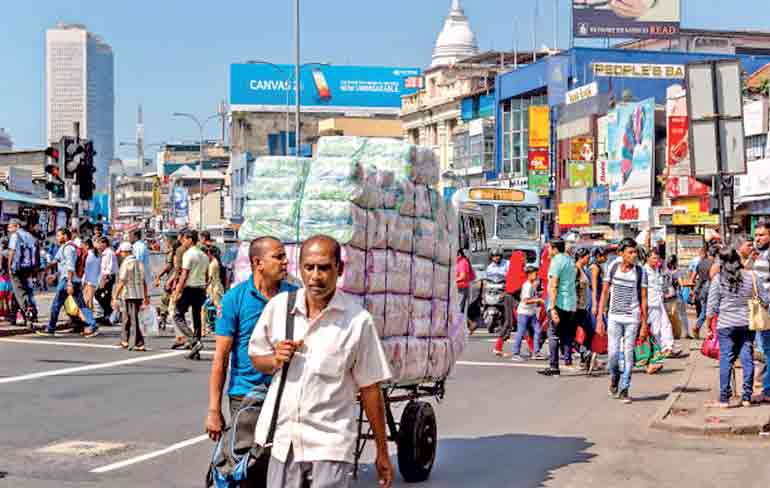Monday Dec 08, 2025
Monday Dec 08, 2025
Thursday, 23 October 2025 00:01 - - {{hitsCtrl.values.hits}}

The Sri Lankan National Budget for 2026 is poised to be a pivotal document, arriving at a critical juncture in the nation’s economic recovery and reform agenda
Sri Lanka’s National Budget will be unveiled on 7 November 2025, and I hope it will be significantly different from the predictable rhetoric and theatrics we have heard and witnessed in the past. This is the first fully fledged Budget of the National People’s Power Government. Typically, on ‘Budget Day,’ the curtains will draw, and the minister of finance will step up and deliver a string of promises which, in hindsight, could have easily found their place in Ripley’s “Believe It or Not.”
 Yet, that is not as bad as the excruciatingly painful theatrical farce which follows the ‘Budget Speech,’ this being the cacophony of opinions from “cheerleaders,” keen to curry favour with the government in power. The chambers of commerce, business associations, professional bodies, corporate leaders, professionals, self-proclaimed pundits, and other vaguely authoritative figures would appear on cue to deliver press releases and ‘polite’ statements that sound like those from the previous year and the many years before, spewing the same tired lexicon of mandatory praise. Some organisations and individuals do provide objective assessments. But sadly, they are more the exception than the norm.
Yet, that is not as bad as the excruciatingly painful theatrical farce which follows the ‘Budget Speech,’ this being the cacophony of opinions from “cheerleaders,” keen to curry favour with the government in power. The chambers of commerce, business associations, professional bodies, corporate leaders, professionals, self-proclaimed pundits, and other vaguely authoritative figures would appear on cue to deliver press releases and ‘polite’ statements that sound like those from the previous year and the many years before, spewing the same tired lexicon of mandatory praise. Some organisations and individuals do provide objective assessments. But sadly, they are more the exception than the norm.
 Through boom, bust, civil war, COVID, and economic implosion, it is very evident that our business aristocracy has perfected the art of conditional commendation. Their utterances are masterpieces of linguistic gymnastics, designed to praise the Government just enough to maintain access, yet vague enough to claim technical neutrality, should the entire fiscal scaffolding collapse. They are like weathervanes fixed perpetually to point towards ‘political expediency,’ regardless of whether a gale of genuine reform or a light puff of populist fluff is blowing.
Through boom, bust, civil war, COVID, and economic implosion, it is very evident that our business aristocracy has perfected the art of conditional commendation. Their utterances are masterpieces of linguistic gymnastics, designed to praise the Government just enough to maintain access, yet vague enough to claim technical neutrality, should the entire fiscal scaffolding collapse. They are like weathervanes fixed perpetually to point towards ‘political expediency,’ regardless of whether a gale of genuine reform or a light puff of populist fluff is blowing.
Year after year, the Budget is monotonously hailed, and praised, for its “bold commitment to digitalisation,” and yet state-owned enterprises continue to function on carbon paper and long waiting periods. It is praised for its priority on “export-led growth,” and still, there is failure on the part of authorities to simplify procedures/processes, address the inadequacy of basic infrastructure, and unblock logistical bottlenecks that frustrate every single entrepreneur striving to increase exports and trying to ship a container. Every year, it is lauded for its promise to broaden the tax net and yet the same taxpayers continue to carry the burden. The Budget utterances exude a warm feeling of expectancy, but the execution is coldly short of promises.
Cheerleaders
Against this background of repeated ‘let-downs,’ it is not difficult to conclude that the praises of the ‘cheerleaders’ are artfully architected, and that the ‘cheerleaders’ know it. Their annual theatrics of optimism are not acts of national solidarity but are, in the main, acts of self-preservation masquerading as statesmanship.
After years of grinding hardships imposed upon them through economic mismanagement, corruption, disregard for the rule of law, cronyism, and nepotism, the populace of this country, the common man and woman, deserve to be better informed about the national Budget. They deserve to be apprised of its pros, cons, challenges, and inherent risks, and to be better sensitised about the positive and negative impacts of the Budget and its potential for tangible improvement in their lives and the lives of their fellow citizens, the farmers, vendors, small business owners, and salaried workers. The Budget must be a signal of their future.
This Budget cannot simply be a collection of fiscal adjustments. It must be a comprehensive, citizen-centric plan for sustainable recovery and equitable growth. In a document of this significance, citizens must look for clarity, commitment to reform, and a balanced approach that manages fiscal discipline while fostering inclusive growth. It is an act of prioritising structural reform over short-term political expediency
So, let us not allow the National Budget 2026 to be another patchwork of populist gestures hidden behind technical jargon and theatrics. Let us, as citizens, demand a Budget that is radically honest, transparently accountable, and fundamentally geared toward national, rather than private, prosperity. Let us be positioned to critically evaluate the proposals and assess them objectively and not be wrong-footed by professional glossing and the carefully selected vague, laudatory adjectives of ‘cheerleaders.’ When a substantial number of business and corporate elites and professionals, the guardians of economic reason, are unable or unwilling to call a spade a shovel, we, the citizens, must devise our own methods of assessing the appropriateness and relevance of the Budget.
Establish a benchmark for National Budget 2026
With that as our goal, let us establish a benchmark for the National Budget 2026, a benchmark against which we can evaluate the key Budget proposals. This, admittedly, is just the first step of a longer process because the extent of its implementation will only be known at the specified milestone dates and at the end of the Budget period. Verite Research, the Advocata Institute and various websites will give us running updates and commentaries once the game starts!
This article highlights what I, as a Sri Lankan citizen deeply invested in the nation’s future, expect from the forthcoming financial blueprint – a set of demands focused on long-term stability, transparency, and social justice. You can establish your benchmarks. This is not about passive hope. It is about defining accountability.
The Sri Lankan National Budget for 2026 is poised to be a pivotal document, arriving at a critical juncture in the nation’s economic recovery and reform agenda. Following years of instability and a major debt default, citizens are looking beyond mere survival measures toward a sustainable, equitable, and growth-oriented future. It must be a statement of national priorities and a blueprint for the next phase of development. The prevailing economic circumstances must not be read as mere statistics but must be seen as the representation of the daily burdens of the ever-rising cost of living, the challenges faced by small businesses, the frustrations of big business and the uncertainty facing our youth.
This Budget cannot simply be a collection of fiscal adjustments. It must be a comprehensive, citizen-centric plan for sustainable recovery and equitable growth. In a document of this significance, citizens must look for clarity, commitment to reform, and a balanced approach that manages fiscal discipline while fostering inclusive growth. It is an act of prioritising structural reform over short-term political expediency.
The success of Budget 2026 must be measured against its ability to deliver on four non-negotiable pillars, being Fiscal Discipline and Revenue-led Consolidation, Pro-Growth and Pro-Competitive Structural Reforms, Human Capital and Social Resilience Investment, and Good Governance and Public Sector Efficiency. For us, the common folk, the scrutiny of this budget must be directed towards key areas that will fundamentally impact on our livelihoods, social security, and long-term economic prospects. These four pillars form the essential benchmark—the “wish-list” against which every citizen, investor, and development partner must judge the sincerity, feasibility, and long-term impact of the 2026 Budget. Just shut out the theatrics of ‘cheerleaders’ and draw your conclusions.
1. Fiscal discipline and revenue-led consolidation
I have never been a fan of the International Monetary Fund (IMF). It is the irresponsible, and reckless, behaviour of Sri Lanka’s leaders that made us servile the IMF. But, having gotten there, we must display an unwavering commitment to fiscal responsibility in keeping with the targets set in the Medium-Term Fiscal Framework (2026-2030) and the IMF Extended Fund Facility (EFF) program. Complacency, post-stabilisation, must not be allowed to set in!
1A. Robust and equitable revenue generation
The primary measure of fiscal success is the government’s ability to fund its operations and debt obligations sustainably.
1B. Prudent expenditure management
While revenue rises, expenditure must be rigorously controlled and quality focused.
2. Pro-growth and pro-competitive structural reforms
Fiscal consolidation must not throttle growth. Budget 2026 must function as an accelerator for a high-growth trajectory, shifting the economy from consumption-led to investment and export-led growth.
2A. Creating a competitive business environment
Sri Lanka’s biggest barrier to growth is the complexity and high cost of doing business.
2B. Sectoral focus for export and FDI
Strategic investment in key sectors is paramount to attract high-quality Foreign Direct Investment (FDI) and boost exports.
3. Human capital and social resilience investment
Sustained growth is impossible without a skilled, healthy populace and a robust safety net for the vulnerable.
After years of grinding hardships imposed upon them through economic mismanagement, corruption, disregard for the rule of law, cronyism, and nepotism, the populace of this country, the common man and woman, deserve to be better informed about the national Budget. They deserve to be apprised of its pros, cons, challenges, and inherent risks, and to be better sensitised about the positive and negative impacts of the Budget and its potential for tangible improvement in their lives and the lives of their fellow citizens, the farmers, vendors, small business owners, and salaried workers. The Budget must be a signal of their future
3A. Education and skills for the future
Budget 2026 must recognise that the next crisis will be one of human capital deficit.
3B. Targeted social protection
Fiscal reform must not compromise the vulnerable.
4. Good governance and public sector efficiency
No amount of resource allocation will succeed without institutional and governance reform to ensure that every rupee spent delivers maximum value.
4A. Fighting corruption and waste
The Budget should not merely fund Government, but reform it.
4B. Climate resilience and green economy
The long-term fiscal health of Sri Lanka is inseparable from its climate vulnerability.
nClimate-smart budgeting: Introduce a Green Budgeting framework that evaluates all major capital projects based on their climate resilience and environmental impact.
nRenewable energy investment: Provide the necessary legal and financial clarity, including through Public-Private Partnership (PPP) frameworks, to attract investment into renewable energy infrastructure, accelerating the shift away from costly and fiscally risky fossil fuels.
In conclusion, the Budget 2026 must be seen as a national covenant—a non-partisan, five-year commitment to structural transformation. The key elements proposed above are not a mere spending list. They are governance reforms dressed as budget proposals.
When evaluating the document in November 2025, the public and the markets must ask:
1. Does it deliver a credible, equity-focused path to a Tax-to-GDP ratio?
2. Does it genuinely simplify and de-bureaucratise the investment landscape to enable the private sector to lead growth?
3. Does it strategically re-allocate public funds to foster a future-fit, skilled human capital base?
4. Does it contain the legislative and funding mechanisms to enforce transparency, SOE reform, and end wasteful expenditure?
If the National Budget 2026 articulates, and robustly funds, these four pillars, we can hail it not just as a promising budget, but as the true turning point for Sri Lanka’s economic future. Anything less is a continuation of the high-risk political budgeting of the past. The time for tough, focused, and non-nonsense fiscal policy is now. Let us ignore the theatrics, cut the fluff, and find the heart of the Budget.
(The writer is currently, a Leadership Coach, Mentor and Consultant and boasts over 50+ years of experience in very senior positions in the corporate world – local and overseas. www.ronniepeiris.com.)